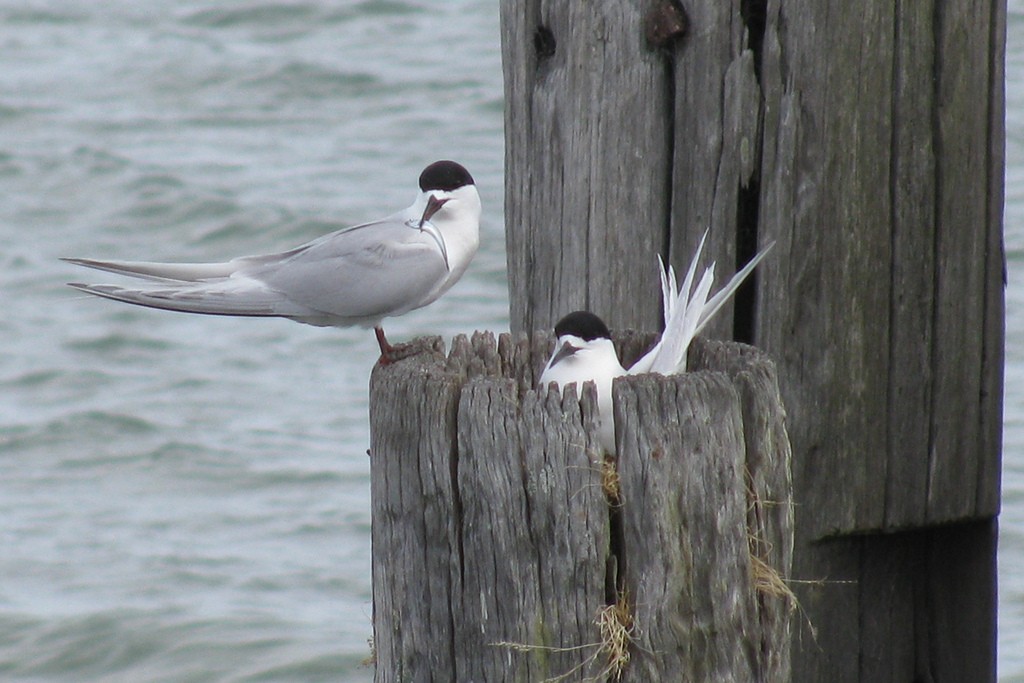White-fronted Tern
A species of Typical Terns Scientific name : Sterna striata Genus : Typical Terns
White-fronted Tern, A species of Typical Terns
Botanical name: Sterna striata
Genus: Typical Terns
Content
Description General Info
Description
White-fronted terns are described as an average-sized bird, their dimensions are 35–43 cm (14–17 in) in length, with a wingspan that is between 79 and 82 cm (31 and 32 in) and weighing on average 130 g (4.6 oz). Females are marginally smaller, but it is difficult to determine when observing them in the wild. Breaking down their monochromatic colouring, the white-fronted terns lightest features are its all-white body, tail and underwing. With their upper wings taking on a light silvery grey hue. Through the breeding season there can be a faint pink colouration on the breast, but it is not always visible. The darkest features consist of their beak, black cap, eyes, feet and the shadowing on the outermost edge of the wingtips. The long ebony like beak is slender and comes to a sharp point that dulls in colour at the tip. It meets at a head covered with a jet-black cap that varies in distance from the crown to the beak, while never joining leaving a white band across the lower forehead. The cap continues over the crown and finishes at the nape, inky black round eyes sit within the cap. The legs are stumpy with a deep burgundy black tone. A defining feature of the white-fronted tern is their forked tail, that is recognisable when in flight and commonly draw comparisons with a swallow's tail. In the breeding season, the outermost feathers of the tail lengthen, exaggerating the already profoundly forked tail. The black cap of non-breeding adults' retreats towards the top of the forehead and above the eyes, while at the same time losing some of its intensity. Immature white-fronted terns appear similar but have speckles of white through the cap. Along with slight colouration through the wings and tail, which appear as a brownish cream. While the juvenile's plumage makes them very pronounced with flickers of light to dark greys and warm milky browns in the upper wing, back, and mantle. The cap is incomplete and mottled while having dark black markings at front and back of eyes. 
Size
42 cm
Life Expectancy
20 years
Nest Placement
Ground
Feeding Habits
White-fronted Tern primarily consume small coastal fish like smelt and pilchards, occasionally venturing inland via waterways. They dive 3-10m to catch shoaling fish, often in large flocks and alongside other seabirds, utilizing nimble flight and forked tails for hunting efficiency.
Habitat
White-fronted Tern thrive in coastal habitats encompassing adjacent marine waters, such as shores and estuaries, often favoring sandy or shingle beaches. Their habitats also span coastal cliffs, offshore rocks, and riverine environments, including stony riverbanks and rocky islets. While white-fronted Tern primarily occupy natural terrains, they occasionally nest on man-made structures and may roam into open sea areas in the winter.
Dite type
Piscivorous
General Info
Feeding Habits
Bird food type
Behavior
The courtship between white-fronted terns begins in early October when the warmth of spring has arrived and can continue into January, with individuals constantly arriving at various breeding grounds. Individual males will fly in from sea with a fish delicately held in its beak; they fly above groups of females and attempt to gain their attention by calling to them. The male may land and strut around with head and fish held high to garner more attention from potential mates and there may be a suggestive approach by female/s to have the fish fed to them. But at this point, the male will swiftly take flight closely followed by one or more of his potential mates. The spectacle continues until there remains only one follower. The pair will land together, the male may offer the fish to the female in acceptance of courtship, or he may disapprove of the female and have the fish for himself. If accepted, the partnership begins. They take to the air together following one another in a magnificent display of flight, to signify their courtship together. White-fronted tern are monogamous, so will stay together for the entire breeding season. 
Species Status
A recent audit published by the Department of Conservation has given S. striata a New Zealand national conservation status of "At risk, declining". While also gaining the regional conservation status of "Regionally Endangered" for the Wellington region. 
Scientific Classification
Phylum
Chordates Class
Birds Order
Shorebirds Family
Gulls Genus
Typical Terns Species
White-fronted Tern 